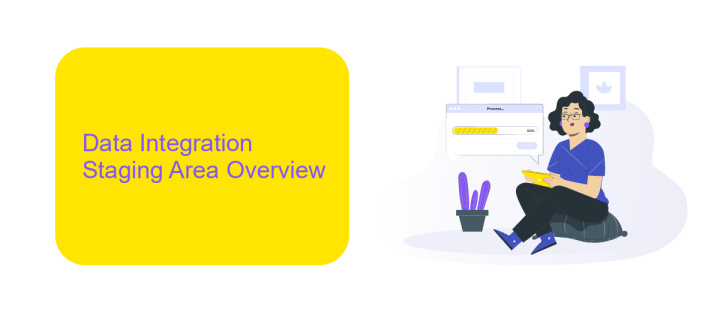Data Integration Staging Area
A Data Integration Staging Area is a critical component in modern data management systems. It serves as an intermediary storage space where data from various sources is collected, cleansed, and transformed before being loaded into a data warehouse or analytical platform. This process ensures data consistency, quality, and readiness for advanced analytics and business intelligence applications.
Introduction
Data integration staging areas are critical components in modern data management systems, serving as intermediaries where raw data is temporarily stored and processed before being moved to a data warehouse or other repositories. These staging areas play a pivotal role in ensuring data quality, consistency, and transformation, enabling organizations to make informed decisions based on accurate and up-to-date information.
- Temporary storage for raw data
- Data cleansing and transformation
- Ensuring data quality and consistency
- Facilitating data migration and integration
By utilizing a data integration staging area, businesses can streamline their data workflows, reduce errors, and enhance the overall efficiency of their data management processes. This approach not only simplifies the handling of large volumes of data but also allows for more sophisticated data analysis and reporting capabilities, ultimately driving better business outcomes.
Data Integration Staging Area Overview

The Data Integration Staging Area serves as an intermediary zone where data from various sources is collected, cleansed, and transformed before being loaded into the target system. This area is crucial for ensuring data consistency, quality, and accuracy. By temporarily storing data, it allows for thorough validation and error-checking processes, minimizing the risk of corrupt or incomplete data entering the final system. This staging process ensures that data integration workflows run smoothly and efficiently, providing a reliable foundation for analytics and decision-making.
Incorporating services like ApiX-Drive can significantly enhance the efficiency of setting up and managing data integrations. ApiX-Drive offers a user-friendly platform that simplifies the process of connecting different data sources and automating data flows. By leveraging such tools, organizations can streamline their data integration efforts, reducing manual intervention and potential errors. This not only saves time but also improves the overall reliability and performance of the data integration staging area, ensuring that high-quality data is consistently delivered to the target systems.
Benefits of Using a Staging Area

A staging area in data integration serves as an intermediate storage space that significantly enhances the efficiency and reliability of data processing. By temporarily holding data before it is loaded into the final destination, a staging area provides a controlled environment for data transformation, cleansing, and validation. This intermediary step ensures that only high-quality, accurate data is moved into the target system, thereby improving overall data integrity.
- Improved Data Quality: The staging area allows for thorough data cleansing and validation, ensuring that only accurate and consistent data is integrated.
- Enhanced Performance: By offloading data transformation processes to the staging area, the performance of the main data warehouse or database is not compromised.
- Data Consistency: It provides a consistent and reliable method for handling data from diverse sources, reducing the risk of data discrepancies.
- Scalability: The staging area can handle large volumes of data, making it easier to scale data integration processes as organizational needs grow.
In conclusion, utilizing a staging area in data integration workflows offers numerous benefits, including improved data quality, enhanced system performance, and greater scalability. These advantages make it an essential component for organizations aiming to maintain high standards of data integrity and operational efficiency.
Challenges in Implementing a Staging Area

Implementing a staging area in data integration processes poses several challenges that organizations must address to ensure efficiency and reliability. One of the primary difficulties is managing the sheer volume of data that needs to be processed, which can overwhelm storage and computational resources.
Another significant challenge is ensuring data quality and consistency. As data is aggregated from multiple sources, discrepancies and errors can arise, necessitating robust validation and cleansing mechanisms. Additionally, maintaining the security and privacy of sensitive information during the staging process is crucial, requiring stringent access controls and encryption methods.
- Handling large volumes of data efficiently
- Ensuring data quality and consistency
- Maintaining security and privacy
- Managing resource allocation and optimization
- Integrating diverse data sources seamlessly
Addressing these challenges requires a comprehensive strategy that includes advanced data management tools, skilled personnel, and continuous monitoring and optimization. By proactively tackling these issues, organizations can leverage their staging areas to facilitate smoother and more reliable data integration processes.
- Automate the work of an online store or landing
- Empower through integration
- Don't spend money on programmers and integrators
- Save time by automating routine tasks
Best Practices for Staging Area Design and Implementation
Effective staging area design begins with clear data governance policies. Ensure data quality by implementing validation rules and standardized formats. Segregate data based on source and type to streamline processing and minimize errors. Utilize incremental loading to reduce load times and system strain. Regularly monitor and audit the staging area to identify and resolve bottlenecks or data discrepancies promptly.
Leverage tools like ApiX-Drive to automate data integration processes, enhancing efficiency and reliability. ApiX-Drive facilitates seamless connectivity between various data sources, ensuring timely and accurate data flow into the staging area. Implement robust security measures, including encryption and access controls, to protect sensitive data. Finally, document all processes and configurations to maintain consistency and support troubleshooting efforts.
FAQ
What is a Staging Area in Data Integration?
Why is a Staging Area important in Data Integration?
What types of data transformations are typically performed in a Staging Area?
How do you automate data integration processes in a Staging Area?
What are the best practices for managing a Staging Area?
Strive to take your business to the next level, achieve your goals faster and more efficiently? Apix-Drive is your reliable assistant for these tasks. An online service and application connector will help you automate key business processes and get rid of the routine. You and your employees will free up time for important core tasks. Try Apix-Drive features for free to see the effectiveness of the online connector for yourself.


